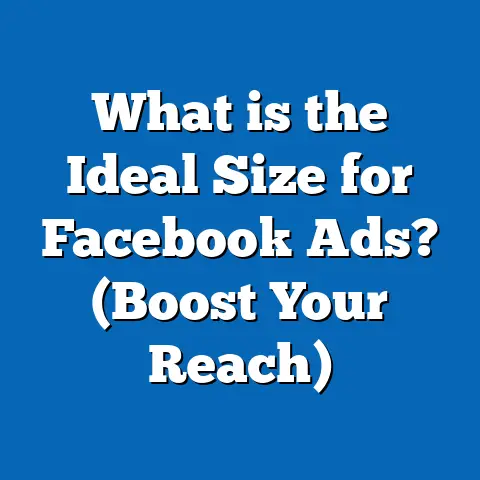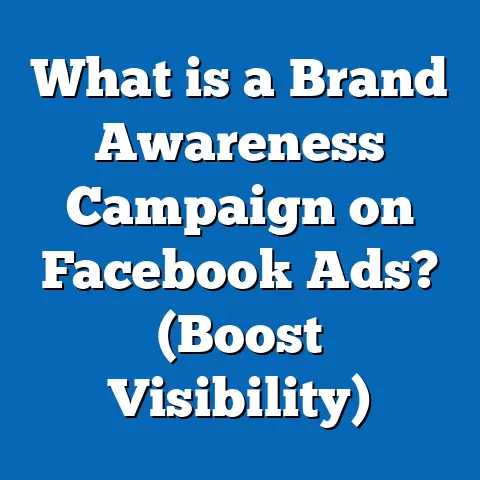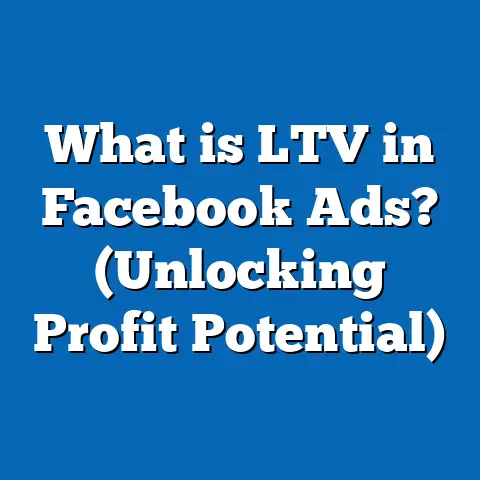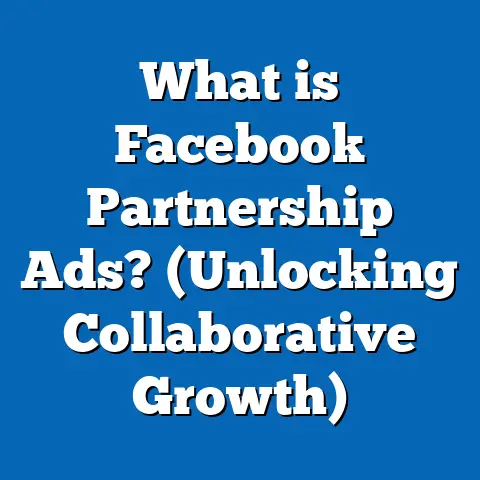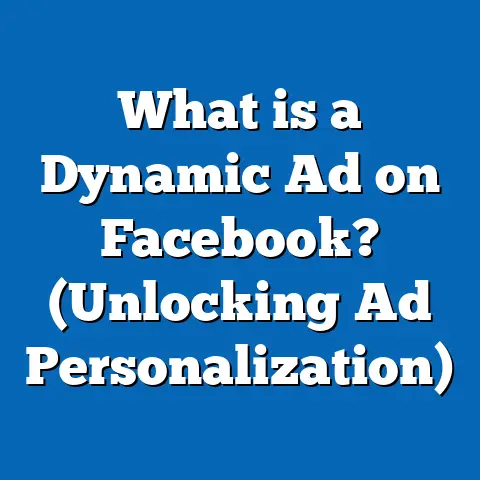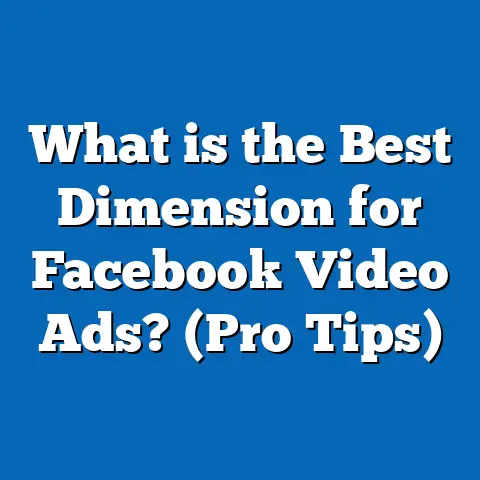What is Facebook Ad Asset Value? (Unlocking Your ROI Potential)
What is Facebook Ad Asset Value? (Unlocking Your ROI Potential)
Introduction: The Power of Value in Facebook Advertising
In the world of digital marketing, every dollar spent counts. Facebook advertising has emerged as one of the most powerful platforms for reaching targeted audiences at scale. However, the true challenge isn’t just creating ads or driving traffic—it lies in understanding the value of what you create and how each part of your ad contributes to your business goals.
Many advertisers focus on broad metrics like campaign reach or total clicks but miss out on a deeper insight: the value of individual ad assets. These assets—images, videos, headlines, descriptions, and calls-to-action—each play a unique role in capturing attention, sparking engagement, and converting prospects into customers.
Unlocking the concept of Facebook Ad Asset Value means shifting from guessing which creative works toward making data-driven decisions that maximize return on investment (ROI). It’s about breaking down your ads into measurable parts and learning exactly how each element influences your bottom line.
Understanding Facebook Ad Asset Value: A Deep Dive
Defining Facebook Ad Asset Value
Facebook Ad Asset Value is an analytical approach that assigns measurable worth to each component of your Facebook ad creative based on its contribution to campaign success. Instead of treating your ad as a single unit, this approach treats it as a collection of valuable parts.
Components Include:
- Visual Assets: Images, videos, carousels
- Text Assets: Headlines, primary text, descriptions
- Call-to-Action Buttons: “Shop Now,” “Learn More,” etc.
- Landing Pages: The page users visit after clicking your ad
Each asset has a different impact on user behavior—some capture attention better, some drive clicks faster, others convert more efficiently.
Why Facebook Ad Asset Value Is Critical Today
The advertising environment on Facebook has evolved drastically with:
- Algorithmic delivery: Facebook’s AI optimizes ad delivery based on asset performance.
- Creative fatigue: Audiences tire quickly of repetitive ads.
- Budget constraints: Businesses must extract maximum value from limited spend.
By understanding asset value:
- You reduce wasted spend on ineffective creative.
- You amplify winning assets for better ROI.
- You gain competitive advantage through smarter optimization.
A 2023 Nielsen study found that advertisers who focused on asset-level optimization increased conversion rates by 22% compared to those optimizing only at the campaign level.
The Evolution of Facebook Ads and Asset Value Focus
From Simple Ads to Complex Asset Ecosystems
Initially, Facebook Ads were straightforward: single image ads with minimal customization. Advertisers measured success mostly by impressions or clicks.
Over time:
- Multiple creative formats (carousel, video, slideshow) were introduced.
- Dynamic creative tools allowed mixing various assets automatically.
- Advanced analytics gave granular insights into asset performance.
This evolution made understanding asset value not just helpful but essential.
Impact of Algorithm Advances on Asset Value
Facebook’s delivery algorithm optimizes for user engagement and conversions by learning which assets resonate best with specific audiences. This machine learning-driven approach means:
- Ads with higher-performing assets get shown more frequently.
- Poor-performing assets are deprioritized automatically.
- Advertisers can leverage automatic asset optimization when armed with the right data.
Detailed Breakdown of Facebook Ad Assets and Their Roles
Visual Assets: The First Impression
Visuals are often the first thing users notice in their feeds. They influence whether a user stops scrolling or keeps going.
Image Ads
- Simplicity and clarity often win.
- Data from WordStream shows that images with faces get 38% higher engagement.
- Colors affect mood and action; blue hues tend to boost trust signals.
Video Ads
- Videos generate 10x more shares than text and images combined (HubSpot).
- Short videos under 15 seconds tend to perform best due to limited attention spans.
- Adding captions increases watch time by 12% (Facebook internal data).
Carousel Ads
- Allow showcasing multiple products or features.
- Increase click-through rates by up to 30% compared to single image ads (AdEspresso).
- Each card can be optimized individually for higher asset value.
Text Assets: Setting Expectations and Driving Action
Copywriting influences perception and persuades users to engage or convert.
Headlines
- Strong headlines increase CTR significantly.
- According to Copyblogger, 8 out of 10 people read headline copy but only 2 out of 10 read rest of content.
- Headlines with numbers or questions tend to perform better.
Primary Text
- Provides context and emotional appeal.
- Research by MarketingProfs shows personalized messaging increases engagement by 14%.
- Concise copy that highlights benefits outperforms feature-heavy text.
Descriptions
- Supplement headlines with additional details.
- Often overlooked but critical for reinforcing messages.
Call-to-Action (CTA) Buttons: Closing the Deal
CTAs guide users toward the desired action. Choosing the right CTA can boost conversion rates by up to 20% according to WordStream.
Common CTAs include:
- Shop Now
- Learn More
- Sign Up
- Download
Testing CTAs against each other helps identify which drives better asset value.
Landing Pages: Extending Asset Value Beyond the Ad
The landing page continues the user journey after clicking the ad. If the page experience clashes with ad messaging or is slow-loading, asset value drops drastically.
Best practices include:
- Fast loading times (under 3 seconds)
- Mobile responsiveness
- Clear messaging alignment with ad copy and visuals
- Streamlined conversion paths (minimal form fields)
Measuring Facebook Ad Asset Value: Tools and Techniques
Using Facebook Ads Manager for Asset-Level Insights
Facebook Ads Manager now offers detailed creative reporting that breaks down performance by asset type.
Key metrics include:
| Metric | Description |
|---|---|
| Impressions | Number of times an asset was shown |
| Click-through rate | Percentage of viewers who clicked |
| Engagement rate | Likes, shares, comments per impression |
| Conversion rate | Percentage of clicks that led to conversions |
| Cost per result | Spend divided by number of conversions |
Creative Reporting Tool Breakdown
This tool provides:
- Performance data for individual images/videos within a dynamic creative set.
- Analysis comparing different headlines or CTAs.
- Ability to isolate top-performing assets for budget reallocation.
Third-party Analytics and Tracking Tools
Tools like Hootsuite Ads, AdEspresso, and Revealbot offer enhanced reporting dashboards that aggregate multi-dimensional data on asset performance.
Calculating Asset Value: Step-by-Step Methodology
Step 1: Gather Comprehensive Data
Collect metrics such as:
- CTR
- Conversion rate
- CPC
- CPA
- Average order value (AOV)
for each asset variant tested.
Step 2: Normalize Data Across Assets
Adjust data for variables like audience size or timing differences using weighted averages or statistical controls.
Step 3: Quantify Impact on Revenue
Calculate incremental revenue generated by each asset using formulas such as: Incremental Revenue=(Conversions from Asset×AOV)−Cost Attributed to Asset\text{Incremental Revenue} = (\text{Conversions from Asset} \times \text{AOV}) – \text{Cost Attributed to Asset}
Step 4: Calculate Return on Ad Spend (ROAS) Per Asset
ROAS=Revenue from AssetCost of Asset\text{ROAS} = \frac{\text{Revenue from Asset}}{\text{Cost of Asset}}
Assets with ROAS > 1 are profitable; those <1 may need improvement or removal.
Step 5: Incorporate Customer Lifetime Value (LTV)
Multiply incremental revenue by average LTV multiplier to assess long-term value impact of assets acquiring customers likely to return.
Case Study: How an Outdoor Gear Retailer Boosted ROI by 28%
Background
The company spent $150,000 across multiple Facebook campaigns targeting outdoor enthusiasts. They tested:
- Five video creatives
- Three image creatives
- Multiple headlines and CTAs
Approach
- Used Facebook’s Creative Reporting to track asset-level performance.
- Calculated ROAS for each asset.
- Shifted 40% of ad spend toward top-performing video creatives and optimized headlines accordingly.
- Paired high-performing assets with customized landing pages aligned with ad messaging.
Results After Three Months
| Metric | Before Optimization | After Optimization | % Change |
|---|---|---|---|
| Overall Conversion Rate | 2.8% | 3.6% | +28.6% |
| Average ROAS | 3.2 | 4.1 | +28.1% |
| Cost per Acquisition (CPA) | $32 | $23 | -28.1% |
This case clearly demonstrates how focusing on asset value can dramatically improve ROI without increasing overall budget.
Practical Implementation Guide: Maximizing Your Facebook Ad Asset Value
Step 1: Audit Current Campaigns for Asset Data
Use Ads Manager Creative Reporting to document current asset performance metrics.
Step 2: Set Up Continuous Testing Protocols
Create rotating tests for visuals, headlines, primary texts, and CTAs with controlled variables for consistent data collection.
Step 3: Develop an Asset Scoring System
Assign scores based on ROAS, engagement rate, CTR, and conversion rates to prioritize assets objectively.
Step 4: Optimize Budget Allocation Dynamically
Shift budgets weekly or bi-weekly toward higher-scoring assets using automated rules or manual adjustment.
Step 5: Refresh Assets Regularly to Combat Creative Fatigue
Rotate in new images/videos every 2–4 weeks depending on audience size and campaign length.
Advanced Strategies to Amplify Facebook Ad Asset Value
Dynamic Creative Ads (DCA)
DCA automatically tests combinations of headlines, images/videos, CTAs in real-time using AI to identify best performers for each audience segment. This reduces manual testing time drastically while maximizing asset value extraction.
Benefits:
- Personalized ad experiences
- Faster optimization cycles
- Increased conversion rates by up to 35% (Facebook internal data)
Automated Rules and AI Tools
Set rules within Ads Manager or use third-party tools like Revealbot to:
- Pause low-performing assets automatically.
- Increase bids/budgets on top assets.
This ensures continuous focus on high-value elements without manual micromanagement.
Common Pitfalls When Measuring Facebook Ad Asset Value
Ignoring External Factors
Factors like seasonality, product launches, or competitive activity can skew asset performance data if not accounted for properly.
Overlooking Attribution Windows
Facebook defaults attribution windows can misrepresent which assets truly drive conversions if users convert days after initial click.
Relying Solely on Short-Term Metrics
Focusing only on immediate conversions ignores customer lifetime value and retention influenced by certain assets.
Failing to Segment Audience Properly
Assets may perform differently across demographics; ignoring segmentation leads to misleading conclusions about asset value.
Comparison with Other Major Platforms’ Asset Optimization Approaches
| Aspect | Google Ads | LinkedIn Ads | |
|---|---|---|---|
| Creative Variety | High – images, videos, carousels | Limited – search ads mostly text-based | Moderate – text + images |
| Testing Capabilities | Dynamic creative + A/B testing | Responsive Search Ads + Experiments | Basic A/B testing |
| Attribution Models | Multi-touch attribution + pixel tracking | Last click & data-driven attribution | Lead Gen form tracking |
| Audience Targeting | Highly granular demographic + interest | Keyword & intent-based targeting | Professional & B2B focused targeting |
| ROI Insights | Detailed creative reporting per asset | Conversion tracking & analytics | Lead gen form & conversion tracking |
Facebook’s rich creative formats paired with dynamic testing provide advertisers with superior tools for deep asset value optimization compared to other platforms primarily text-based or limited in creative options.
The Future of Facebook Ad Asset Value Optimization
AI-Powered Creative Generation
Emerging technologies enable marketers to generate ad copy and visuals dynamically using AI models trained on high-performing examples — further accelerating asset testing cycles.
Privacy-Centric Attribution Models
With privacy changes limiting data availability (iOS changes), new methods like aggregated event measurement will become key in measuring true asset impact accurately.
Increased Emphasis on Short-form Video Assets
Reels ads and other short-form content are growing rapidly in importance; optimizing these new asset types will be critical moving forward.
Summary: Unlocking Your ROI Potential Through Facebook Ad Asset Value Mastery
Understanding and optimizing Facebook Ad Asset Value transforms ad campaigns from budget drains into profit engines by:
- Breaking down ads into measurable components.
- Leveraging detailed analytics for data-driven creative decisions.
- Testing continuously and reallocating budgets toward highest-value assets.
- Integrating qualitative insights alongside quantitative metrics.
- Harnessing advanced Facebook tools like dynamic creatives and automation rules.
By adopting these practices today, marketers can future-proof their strategies amidst evolving consumer behavior and platform developments while maximizing every advertising dollar invested.
Actionable Takeaways & Next Steps Checklist
- Audit: Use Ads Manager Creative Reporting to gather detailed asset performance metrics.
- Test: Implement systematic A/B tests across visuals, headlines, CTAs regularly.
- Analyze: Calculate ROAS per asset including long-term customer LTV impacts.
- Optimize: Shift budgets dynamically toward top-performing assets using automation.
- Refresh: Rotate new creatives frequently to avoid audience fatigue.
- Learn: Stay updated on latest Facebook tools and industry trends impacting asset optimization.
- Expand: Consider multi-platform comparisons and integrate learnings for holistic strategy.
If you want me to provide templates for tracking asset value or a step-by-step tactical guide tailored specifically for your business niche, just let me know!

